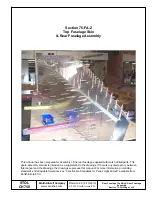
Air Tractor, Inc.
Maintenance Page 01
AT-502A/502B/504
March 14, 2018
ENGINE MAINTENANCE
Introduction
This section of the Maintenance/Inspection manual written by Van B. Dardis, Lubbock, Texas.
The Pratt & Whitney PT6A series of engines have been proven to be one of the most reliable
powerplants available today. The engine is a lightweight, reverse flow, free turbine engine utilizing two
independent turbine sections. One section drives the compressor in the gas generator section and the
second drives the propeller shaft through a gear reduction box.
Air enters the engine through an annular plenum chamber, passing through a three stage axial and one
stage centrifugal compressor. In the combustion chamber, fuel mixed with air is ignited. The expanding
gases are directed through the two turbines and out the exhaust ports on opposing sides of the engine.
While an unfamiliar and complex looking piece of equipment, the engine is easy to understand and,
with a little time, will begin to talk to you like all the others before.
Maintenance
Maintenance on your Pratt & Whitney PT6A engine will be one of a preventative nature. Time and
experience have proven that an engine properly maintained will give excellent service with a minimum of
down time and expense. Establish a routine maintenance schedule and adhere to it as closely as possible,
taking into consideration the problems of busy schedules in mid-season.
Equally important to proper maintenance is the keeping of records. Maintenance records on a turbine
engine are extremely important and every effort should be made to see that all the work performed is
properly recorded. A record of the number of starts and flights MUST be kept for figuring cycle counts on the
rotor components in your engine at each annual. The cycles are figured using the number of starts and
flights, with a formula found in the applicable engine Service Bulletin. When these parts reach their life limit in
either hours consumed or cycles, they must be removed and discarded. Few of you will ever see a part
reach that limit but the records must be kept for your logbooks to be in proper order.
While on the subject of record keeping, it is a good idea to keep a small pad in the cockpit to record
engine parameters on a regular basis. For example, on the return from your first load each day, at the same
altitude and with the same torque and propeller RPM setting, record the following: hourmeter time, OAT, ITT,
Ng, oil pressure, and fuel pressure. When trouble appears, this information will save lots of time
troubleshooting and will also give you a good picture of the trends in your engine. Remember, no two
engines will run the same. The change in your engine parameters over a period of time is what really
matters. Keep it written down because your mind will deceive you over the span of a season and it is the
best way for maintenance personnel to make an accurate diagnosis when problems arise.
Cleaning Your Engine Exterior
The cleaning of your engine may be accomplished only when the engine is cold. NEVER WASH A HOT
ENGINE. You may wash the engine exterior with water or with a petroleum base solvent. While cleaning
your engine, it is a good time to inspect all the engine externals; tubing, wiring, control linkages, hose
assemblies, etc. You should look for evidence of wear, chafing, cracks, corrosion, fuel and oil leaks, and the
security of hoses, brackets, clamps and connections. Also inspect your air inlet system for signs of leaks that
would allow unfiltered air into the engine.
Summary of Contents for AT-502A
Page 19: ...This Page Intentionally Left Blank...
Page 91: ...This Page Intentionally Left Blank...
Page 92: ......
Page 93: ......
Page 94: ......
Page 95: ......
Page 96: ......
Page 97: ......
Page 98: ......
Page 99: ......
Page 100: ......
Page 101: ......
Page 102: ......
Page 103: ......
Page 104: ......
Page 105: ......
Page 106: ......
Page 107: ......
Page 108: ......
Page 109: ......
Page 110: ......
Page 111: ......
Page 112: ......
Page 113: ......
Page 114: ......
Page 115: ......
Page 116: ......
Page 117: ......
Page 118: ......
Page 119: ......
Page 120: ......
Page 121: ......
Page 122: ......
Page 123: ......
Page 124: ......
Page 125: ......
Page 126: ......
Page 127: ......
Page 128: ......
Page 129: ......
Page 130: ......
Page 131: ......
Page 132: ......
Page 133: ......
Page 134: ......
Page 135: ......
Page 136: ......
Page 137: ......
Page 138: ......
Page 139: ......
Page 140: ......
Page 141: ......
Page 142: ......
Page 143: ......
Page 144: ......
Page 145: ......
Page 146: ......
Page 147: ......
Page 148: ......
Page 149: ......
Page 150: ......
Page 151: ......
Page 152: ......
Page 153: ......
Page 154: ......
Page 155: ......
Page 156: ......
Page 157: ......
Page 158: ......
Page 159: ......







































